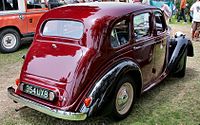Standard Flying Fourteen
| Standard Flying Fourteen Standard Fourteen | |
|---|---|
 Standard Fourteen Saloon | |
| Overview | |
| Manufacturer | Standard Motor Company |
| Also called | Standard 14 [1] |
| Production | 1937-1940 [2] 1945-1948 [3] 22,229 (post war) [3] |
| Assembly | United Kingdom Australia [4] |
| Body and chassis | |
| Body style | 4-door saloon 2-door drophead coupe 4-door estate |
| Related | Standard Twelve |
| Powertrain | |
| Engine | 1,776 cc Straight-4 side-valve [5] |
| Transmission | Four speed manual [5] |
| Dimensions | |
| Length | 165 in (4,191 mm) [5] |
| Width | 63 in (1,600 mm) [5] |
| Height | 63 in (1,600 mm) [5] |
| Chronology | |
| Predecessor | none |
| Successor | Standard Vanguard |
The Standard Flying Fourteen is an automobile which was produced by the British Standard Motor Company from 1937 to 1940 [2] and, as the Standard Fourteen,[1] from 1945 to 1948.[3] The Flying Fourteen name was used initially as the model represented a move away from the very perpendicular look of many cars at the start of the 1930s to a more streamlined look that Standard, in common with a number of manufacturers in England and France, adopted towards the end of the decade.
The Flying Fourteen was offered as a four door saloon on a 108 inch wheelbase post war 100 inch with a 1,776 cc side valve four cylinder engine.[2] Drophead coupe and estate car variants were offered post-war, along with a four door saloon.[3] The post-war model could be distinguished from its predecessor by a lack of bonnet louvres.[3] the post war 14hp is a modified prewar 12hp car fitted with a 14 hp engine option The engine and transmission from the Fourteen were also used in the Jaguar 1½ Litre (retrospectively known as the Jaguar Mk IV).
Press reports praised the economy, smooth running, roominess and finish of the Fourteen. Luggage was relegated to an external folding bumper carrier, which at the time was not unusual.[5]
-
1948 Standard Fourteen saloon
-
1948 Standard Fourteen saloon
References
- ^ a b Standard 1946, www.classiccarcatalogue.com Retrieved 3 December 2015
- ^ a b c Michael Sedgwick and Mark Gillies, A-Z of Cars of the 1930s, Bay View Books Ltd, 1993, page 186
- ^ a b c d e Michael Sedgwick and Mark Gillies, A-Z of Cars 1945-1970, Haymarket Publishing Ltd, 1994, page 185
- ^ Gavin Farmer, Great Ideas in Motion, A History of Chrysler in Australia, 2010, page 405
- ^ a b c d e f "Second Hand car guide supplement". Practical Motorist. 6 Nbr 68: between pages 768 & 769. April 1960.


